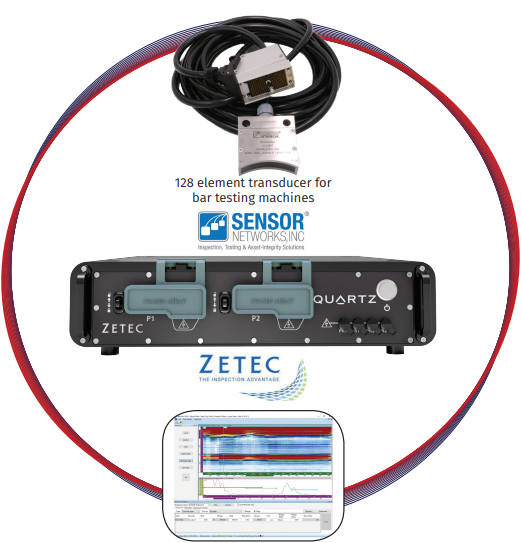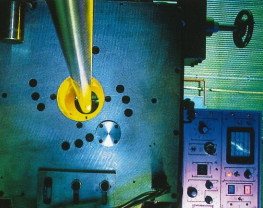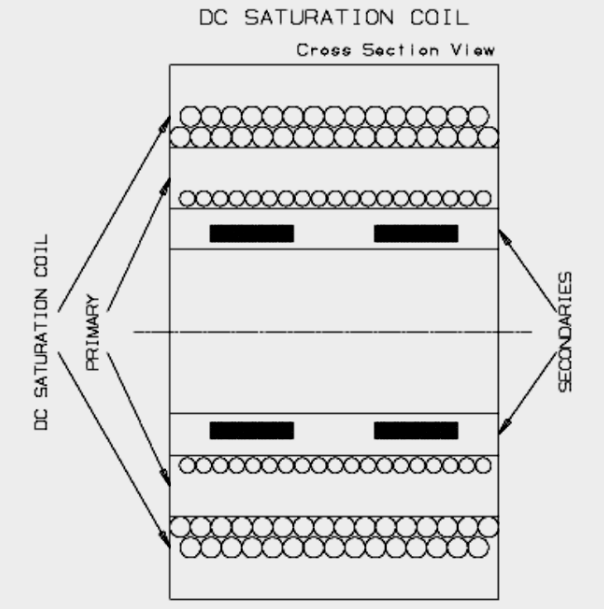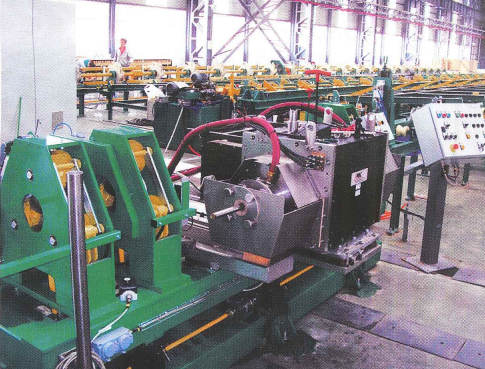Authored by Michael Rakos, District Manager
ASNT PHILADELPHIA CHAPTER MEETING FEBRUARY 2012
Introduction
Magnetic Analysis Corporation, most commonly referred to as MAC, is a major worldwide source of NDT equipment including eddy current, flux leakage, and ultrasonic inspection systems. Since its beginnings to present day, MAC has been the first to market with various types of groundbreaking NDT equipment. These equipments range from the first successful encircling coil electromagnetic tester in the U.S. to the world’s first spinning probe eddy current tester. Various significant types of NDT equipment releases, by both MAC and others, will also be chronicled leading up to the present day. MAC has a long colorful history, and many interesting historical developments led up to its inception and development of product lines through history.
Magnetic Analysis Corporation was founded in 1928 in Long Island City, NY, USA, by William S. Gould and William S. Gould Jr. to develop a group of patents for nondestructive electromagnetic testing of steel bars. William S. Gould was a New York industrialist and former President of the Gould National Battery Company. These acquired patents dated from 1919 through 1928 and had been developed by a previous corporation known as the “Burrows Magnetic Equipment Corporation.” This predecessor company included several notable people, including Dr. Charles Burrows, a former physicist from the U.S. Bureau of Standards, Bradley Stoughton, a Professor of metallurgy at Lehigh University, and Elmer S. Imes, the second African American PhD physicist in the United States (1).
The term “Magnetic Analysis” was originated by Dr. Charles Burrows. He defined it as the investigation of the mechanical properties of a magnetic material exclusively through its magnetic properties. In 1917, Dr. Burrows presented a paper at the ASTM annual meeting entitled “Some Applications of Magnetic Analysis to the Study of Steel Products” (2). The railroad industry, including the Pennsylvania and New York Central, already had an interest, but now other steel-related industries were taking notice. His paper also attracted the attention of the scientific community, and the idea of testing the quality of steel through its magnetic properties began to be taken seriously. Many individuals became inspired to develop a successful electromagnetic tester, and a flurry of patents would soon follow, including those of Dr. Burrows.
Although successful laboratory experiments in electromagnetic testing began in the prior century, the application of electromagnetic test principles into viable equipment for the steel manufacturing industry remained elusive. This was the case prior to, and even for a short time after, MAC’s founding. At first, the equipment based on MAC’s purchased patents didn’t work as needed. After a few short years, and several new patents, persistence would eventually lead MAC in 1934 to the first successful Electromagnetic Tester in the United States (Fig. 1 on left shows the original logo for MAC).

Early Attempts at Practical Testing
The use of 1920s technology to develop practical high-speed electromagnetic testing was based on very basic fundamentals discovered in the prior century. The first known application of using the magnetic properties of a metal to locate flaws within it occurred in 1868. Lt. Stephen Martin Saxby of the British Royal Navy noticed unusual deflections of a compass needle when passed over a flaw. He first applied this technique to cannon barrels on ships in the Royal Navy dockyard (3).
Shortly after this discovery in 1877, Anaxamander Herring of Albany, New York, patented a similar technique in the U.S. for use on rail (4). He proposed that the rail should have current passed through it first to properly magnetize it. Charles Ryder of Cleveland, Ohio, was first in the U.S. to patent an apparatus for testing steel (5). The intent of his device was to measure carbon content, and this could be considered the first electromagnetic comparator. It used a compass needle in the center and a magnetized steel part on either side. One part was to be of known carbon content, and the other side was to be measured on the calibrated scale when the needle came to the centered position.
Two years later, Anaxamander Herring patented another apparatus intended for testing the tensile strength of steel wire or strip (6). His device first magnetized the material with an electromagnet and then used a gauss meter to measure the retained field strength as the material was spooled through.
The Influence of the Railroad
The railroad industry deserves much early credit for spawning the incentive to develop a viable high-speed electromagnetic test. Rail inspections were initially performed solely by visual means. Visual inspections at best only located external defects, and sometimes the subtle signs of large internal problems.
In 1911, the need for a better inspection method became a very high priority. A derailment occurred at Manchester, NY, in which 29 people were killed and 60 seriously injured. In the U.S. Bureau of Safety's (now the National Transportation Safety Board) investigation of the accident, a broken rail was determined to be the cause. The bureau established that the rail failure was caused by a defect that was entirely internal and probably could not have been detected by visual means. The defect was called a transverse fissure (example shown on the left in Fig. 2). In 1912, the railroads, in conjunction with the U.S. Bureau of Standards, began investigating the prevalence of this defect and found transverse fissures were widespread (7).

Involvement of the U.S. Bureau of Standards
In 1915, the Bureau of Standards, with Dr. Burrows, began experiments to develop magnetic testing equipment for locating and measuring transverse fissures in rails (7). Dr. Burrows first became interested in the relationship between electromagnetic and physical properties of steel in 1906 while managing the magnetic section of the U.S. Bureau of Standards in Washington (8). He gained early fame for inventing the “Burrows Permeameter” in 1909, and it became the standard instrument for measuring and classifying magnetic properties at the Bureau (9).
His original idea for high-speed testing was a simple flux leakage concept he later filed for a patent in 1917 (10). A winding encircled the bar in which a DC current was passed to create a magnetic field, and a separate pickup winding connected to a galvanometer would respond to the leakage field caused by changes in the steel bar. An inspector would then interpret the meter readings caused by the leakage field to identify flawed areas and hopefully estimate the severity.
At the Bureau of Standards laboratory, this equipment was successful in tests, but when adapted for actual tests on track, it was not able to differentiate actual defects in rails from the strains caused by slipping wheels, surface irregularities, and cold working by car wheels (7).

Burrows Magnetic Equipment Corporation
Charles Burrows resigned his post at the Bureau of Standards in 1918, and started his own research laboratory in the New York City area (11). His intent was to work on developing equipment to meet the needs of the steel industry and in particular, for testing steel bar. Being quite active in the ASTM, he was chosen in this same year to chair a newly formed committee called “committee A-8 on Magnetic Analysis” (12). His work soon became noticed by the Federated Engineers Development Corporation. They were comprised of noted engineers, scientists, and businessmen. Their purpose was to review hundreds of inventions and choose a few that they would promote (13). They had particular interest in Burrows work, and in 1924, the “Burrows Magnetic Equipment Corporation” was formed as a subsidiary. The aim was to design equipment for the steel industry that would prove workable in an industrial environment (8). Many prototype equipments were built, but the most promise for high speed inspection was developing his flux leakage tester patent (10) known as “Defectoscope” (as shown in fig.3). When MAC was formed several years later, the hope was that this equipment, for testing wire rope, rails, bar and strip, would be well received by the steel industry. However, the moving coil system, combined with its use of a fragile laboratory mirror galvanometer proved ill suited for the needs of the steel plants. These mirror galvanometers were used extensively in scientific instruments before reliable, stable amplifiers were available. A concave mirror attached to the pointer would reflect light onto a screen. This concave mirror was often knocked off the pointer needle from large signals and required repair. Viewing had to be done in a darkened area, usually by draping a tarp over the equipment. Several of these “Defectoscope” equipments were put into service by industry and government, and stayed in use for many years despite their shortcomings. Dr. Burrows succeeded in demonstrating the feasibility of indicating large discontinuities in steel by measuring changes in permeability (permeability is the relative ability of the material to pass magnetic lines of force). Normal variations in permeability of most steel however, produced extreme swings in the readings such that the detection of small and moderate defects was not really possible. Charles Burrows fiercely believed only one set of mechanical characteristics correlated to a given set of magnetic characteristics, and much of his equipment reflected that concept. He had a multitude of interesting patents throughout the 1920’s, most of which were founded in solid theory, but in practice did not provide the accuracy or high speed testing required by the manufacturing industry. The tester shown in Figure 4 (14) applied a rotating magnetic field on a part such as a bearing race, and measured the mechanical force to which the part was attracted in this field. A second version using three phase AC was also designed.

A portable flux leakage plate tester (fig.5) was also an invention of Charles Burrows (15). It incorporated a marking system to spray paint on defective areas. Although this version never saw service, the patent offered some protection to MAC in the 1989 release of its TBT I Aboveground Tank bottom tester.

Sperry Develops Successful Rail Testing
In 1923, Dr. Elmer Sperry, started to develop and build a rail inspection car with the capability of detecting transverse fissures in railroad rails. In 1927 Sperry built an inspection car under contract with the American Railway Association. A small flatbed in front of the cab contained the inspection equipment. The operator and recording devices were housed in the cab. His original design energized the rail with current and measured variations in potential drop by means of a pair of contacts. The average conditions of the surface of the rail prevented continuous contact of the searching units with the rail, and caused many false indications. Extensive research was continued to develop a practical means of cleaning the rail before testing, but no solution was found and the method was abandoned (16). Shortly afterward in 1928, Sperry and his engineers successfully adapted the Burrows flux leakage method, combined with Herring’s manual technique for rail testing 50 years before. Instead of inducing a magnetic field by means of an external coil, contact brushes passed a large current through the rail to set up the field. The sensing coil would pick up leakage field around transverse defects as the testing car sped along. He called this the “Induction method” and it is shown on the left in figure 6.

MAC is Founded
After MAC’s acquisition of the Burrows patents in 1928, much effort was put into making them work for practical applications. The design shown in figure 7 (17) by Burrows, is a modified Induction Balance. David E. Hughes experimented with a similar circuit in 1879 for investigating the conductivity of metals (18), and it would later be applied in metal detectors. The system consisted of two identical transformer like primary and secondary coil windings at each end of the device, with the secondaries inductively opposing one another. These windings know as “coils” encircled the bar, with the secondary winding being closest to the bar, and the primary coil wound on top of the electrically insulated secondary. One coil would be chosen as the reference, and would contain a standard bar for all others to be measured against, and not to be moved.
The other coil would be for testing, and the bars to be inspected would be continually passed through it. Any change in the magnetic properties of the test bar should be observed by a meter deflection. This basic theory is sound, and is the basis for all modern comparators today. However, there were too many practical problems for this basic circuit to work effectively, namely the difficulty in making two coils precisely impedance matched. Many modifications of this induction balance system would be explored by MAC before it worked effectively.
Dr. Theodor Zuschlag Joins MAC
In 1931, Dr. Theodore Zuschlag, a native of Germany, became Chief Engineer of MAC. He successfully developed the work of Dr. Burrows who had died shortly after the company’s founding (19). Dr. Zuschlag emigrated in 1925, and immediately started work for the Taumac Corporation out of New York developing electromagnetic prospecting techniques (20). He filed several patents for using magnetic fields to locate subsurface mineral deposits, and he had a very good understanding of the challenges facing the fledgling MAC. He quickly refined the work of Burrows into MAC’s first successful tester. The principal discovery he patented was a proper balance compensation of the secondary coils using a bridge network (fig.7) (21). This enabled adjustment to zero out any differences in the system which was always a problem in the past. Slight variations in test coils, materials, or stray fields no longer posed a problem. He also invented a novel technique for analyzing phase shift of wave forms without an oscilloscope. It used a synchronous motor driving a mechanical rectifier and could read phase shifts using two galvanometers. He recognized at the time the early oscilloscope displays were small and difficult to use, as well as too fragile for most environments MAC needed to operate in. He patented this technique for use in other applications, even one using a rotating neon tube known as a Neoscope (22). He later refined the technique using mixing transformers instead of moving parts.

First Successful Electromagnetic Tester to Identify Cracks in Steel Bars
Finally in 1934, MAC introduced their first successful electromagnetic tester to identify cracks in steel bars. It was housed in a wooden cabinet, and at first was met with considerable skepticism from early customers. But MAC believed so strongly in this tester that they offered this equipment on a lease basis so the customer would not have to make a capital investment. With this incentive, in 1934 Union Drawn Steel of Hartford, CT, (which is now part of Republic Steel) became the first company to install a MAC electromagnetic tester. MAC's concept of an operating lease for NDT equipment combined with highly skilled field staff soon became a successful part of MAC's marketing program, one that remains to this day. This equipment featured Dr. Theodore Zuschlag’s coil balance compensation circuit, and specially arranged test coils at each end of the device with a several inch air gap in between, instead of putting one offline with a known good bar inserted. This novel technique in effect, “nulled” out changes caused by temperature and other local variations in the same bar being tested that may have otherwise caused defect-like indications. A 60Hz AC current energized the two primary coils, and changes in the bar’s permeability directly under each of the secondary coils would translate to an impedance change in the secondary circuit, and deflect a galvanometer. One of the most important contributions of Dr. Zuschlag was the differential or “null” secondary winding (23). He combined the two separate coils of the first-generation tester into one, such that they shared the same primary. It enabled finding very short flaws at high speeds, and is at the foundation of the test coils used today with modern eddy current equipment. The coil pictured in figure 8 was about two feet in length and had an interchangeable core on which the secondary coils were wound. This enabled the use of different sizes to reduce the air gap between the material and the test coil (known as fill factor). This coil also had an absolute winding, as well as end-sensing windings to be used in conjunction with an end suppression circuit.
With the success of the first tester, research on electromagnetic testing continued at MAC and Republic Steel in the United States. Dr. Zuschlag refined the test methods he had developed, introducing improved balancing and phase analysis circuits. This equipment utilized the patented test coil and could test at speeds up to 200ft/min. A flaw detection circuit would now illuminate an indicator on the instrument when a defect passed by (23). This eliminated the need for the operator to concentrate his gaze on a meter, which may have responded quickly, or not at all for short flaws at high speed. This equipment was called a “Dual Method” since an absolute test was also employed to sort bars on alloy or to find long continuous defects. This method could be used by itself or at the same time as the null test, but required the observation of two meters for amplitude differences or phase shift. Another important feature of this equipment was end suppression, which prevented false indications as front and back ends came through the test coil.

Republic Steel Develops Saturation Technique
While MAC was perfecting its permeability test, Republic Steel (which had their own research facility in Ohio) had some major breakthroughs in eddy current testing. They were the first to patent a DC saturation technique in 1936 to eliminate the effects of permeability (24). This allowed steel to be examined by eddy currents for changes exclusively in conductivity, and enabled inspection of soft annealed or hot rolled bar and tubes. A higher frequency of 500Hz was required to get enough eddy currents on the surface to see a defect. This equipment and method, sometimes referred to as a “Farrowtest,” was named for the inventor Cecil Farrow, who developed it along with Horace Knerr and Archie Black. This equipment was not without its problems, the expensive coil system required immersion in oil much like a transformer to keep it cool. It was never marketed commercially or used outside of Republic Steel. MAC equipment was still used by Republic during this period, and a friendly relationship was maintained.



